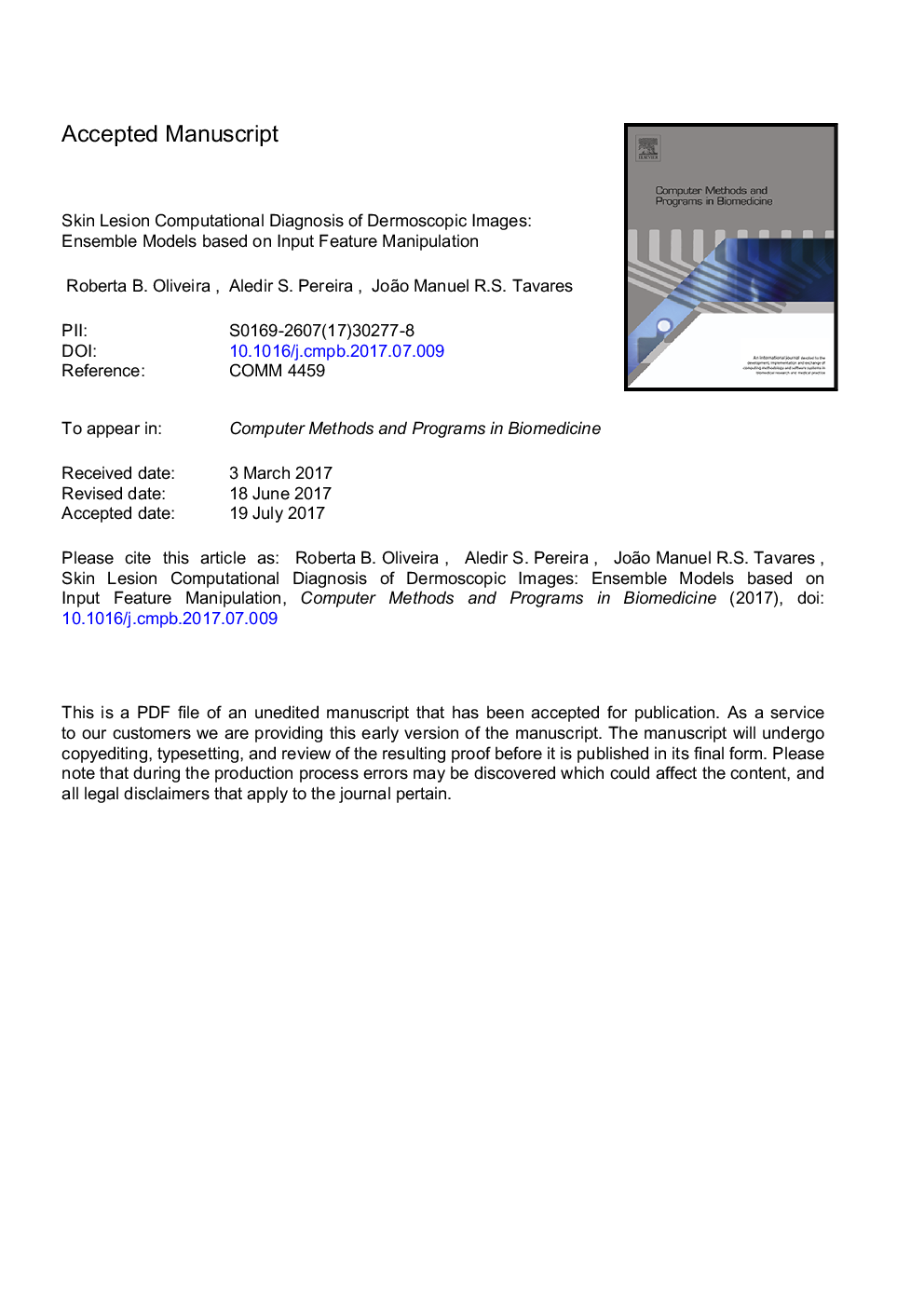| کد مقاله | کد نشریه | سال انتشار | مقاله انگلیسی | نسخه تمام متن |
|---|---|---|---|---|
| 4958046 | 1445231 | 2017 | 27 صفحه PDF | دانلود رایگان |
عنوان انگلیسی مقاله ISI
Skin lesion computational diagnosis of dermoscopic images: Ensemble models based on input feature manipulation
ترجمه فارسی عنوان
تشخیص محاسبه ضایعه پوست تصاویر درماتوسکوپی: مدل های گروهی بر اساس دستکاری ویژگی های ورودی
دانلود مقاله + سفارش ترجمه
دانلود مقاله ISI انگلیسی
رایگان برای ایرانیان
کلمات کلیدی
طبقه بندی عکس، استخراج ویژگی، انتخاب ویژگی، مجموعه ای از طبقه بندی کنندگان، تشخیص محاسباتی،
ترجمه چکیده
زمینه و اهداف: تعداد مرگ و میر ناشی از ملانوم در سراسر جهان در سالهای اخیر افزایش یافته است، زیرا ملانوما نوع سرطان پوست است. سیستم های محاسباتی برای کمک به متخصصین پوست در تشخیص زودهنگام سرطان پوست یا حتی برای نظارت بر ضایعات پوستی توسعه یافته اند. با این حال، هنوز هم یک چالش برای بهبود طبقه بندی برای تشخیص چنین ضایعات پوستی وجود دارد. هدف اصلی این مقاله ارزیابی مدل های طبقه بندی گروه های مختلف بر اساس دستکاری ویژگی های ورودی برای تشخیص ضایعات پوست است. روشها: فرایندهای دستکاری ویژگی ورودی براساس انتخابهای زیر مجموعه ویژگی از ویژگیهای شکل، تنوع رنگ و تحلیل بافت برای تولید تنوع برای مدلهای گروهی است. سه مدل انتخاب زیر مجموعه در اینجا ارائه می شود: (1) یک مدل انتخاب زیر مجموعه ای بر اساس گروه های مشخص خاص، (2) یک مدل انتخاب زیر مجموعه مبتنی بر همبستگی و (3) یک مدل انتخاب زیر مجموعه ای بر اساس الگوریتم های انتخاب ویژگی. هر مدل طبقه بندی گروه با استفاده از یک طبقه بندی بهینه سازنده جنگل تولید می شود و با استراتژی رای اکثریت ترکیب شده است. مدل های پیشنهادی بر روی مجموعه ای از 1104 تصاویر درماتوسکوپی با استفاده از روش اعتبارسنجی متقابل استفاده شد. یافته ها: نتایج به دست آمده با استفاده از مدل طبقه بندی اول گروه به دست آمده است که گروهی از زیر مجموعه های ویژگی را بر اساس گروه های ویژگی خاص تولید می کند. سیستم تخمین زخم ضایعات پوستی دقت 94.3٪، حساسیت 91.8٪ و ویژگی 96.7٪ را بدست آورد. نتیجه گیری: فرآیند دستیابی به قابلیت ورودی بر اساس زیرمجموعه های ویژه ای، بیشترین تنوع را برای مدل طبقه بندی گروه با نتایج بسیار امیدوارانه ایجاد کرد.
موضوعات مرتبط
مهندسی و علوم پایه
مهندسی کامپیوتر
علوم کامپیوتر (عمومی)
چکیده انگلیسی
Background and objectives: The number of deaths worldwide due to melanoma has risen in recent times, in part because melanoma is the most aggressive type of skin cancer. Computational systems have been developed to assist dermatologists in early diagnosis of skin cancer, or even to monitor skin lesions. However, there still remains a challenge to improve classifiers for the diagnosis of such skin lesions. The main objective of this article is to evaluate different ensemble classification models based on input feature manipulation to diagnose skin lesions. Methods: Input feature manipulation processes are based on feature subset selections from shape properties, colour variation and texture analysis to generate diversity for the ensemble models. Three subset selection models are presented here: (1) a subset selection model based on specific feature groups, (2) a correlation-based subset selection model, and (3) a subset selection model based on feature selection algorithms. Each ensemble classification model is generated using an optimum-path forest classifier and integrated with a majority voting strategy. The proposed models were applied on a set of 1104 dermoscopic images using a cross-validation procedure. Results: The best results were obtained by the first ensemble classification model that generates a feature subset ensemble based on specific feature groups. The skin lesion diagnosis computational system achieved 94.3% accuracy, 91.8% sensitivity and 96.7% specificity. Conclusions: The input feature manipulation process based on specific feature subsets generated the greatest diversity for the ensemble classification model with very promising results.
ناشر
Database: Elsevier - ScienceDirect (ساینس دایرکت)
Journal: Computer Methods and Programs in Biomedicine - Volume 149, October 2017, Pages 43-53
Journal: Computer Methods and Programs in Biomedicine - Volume 149, October 2017, Pages 43-53
نویسندگان
Roberta B. Oliveira, Aledir S. Pereira, João Manuel R.S. Tavares,
